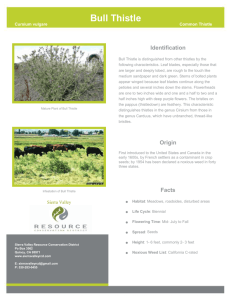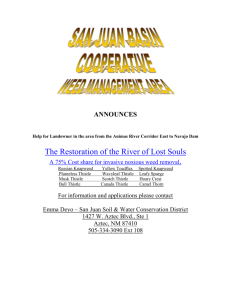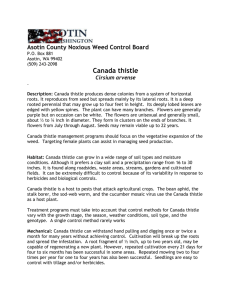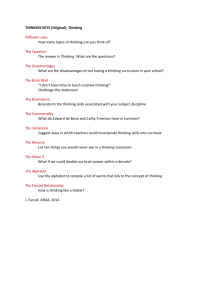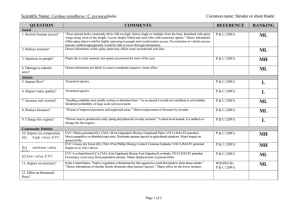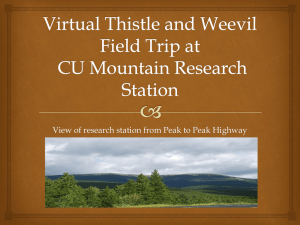Proclaimed Plant Policy
advertisement
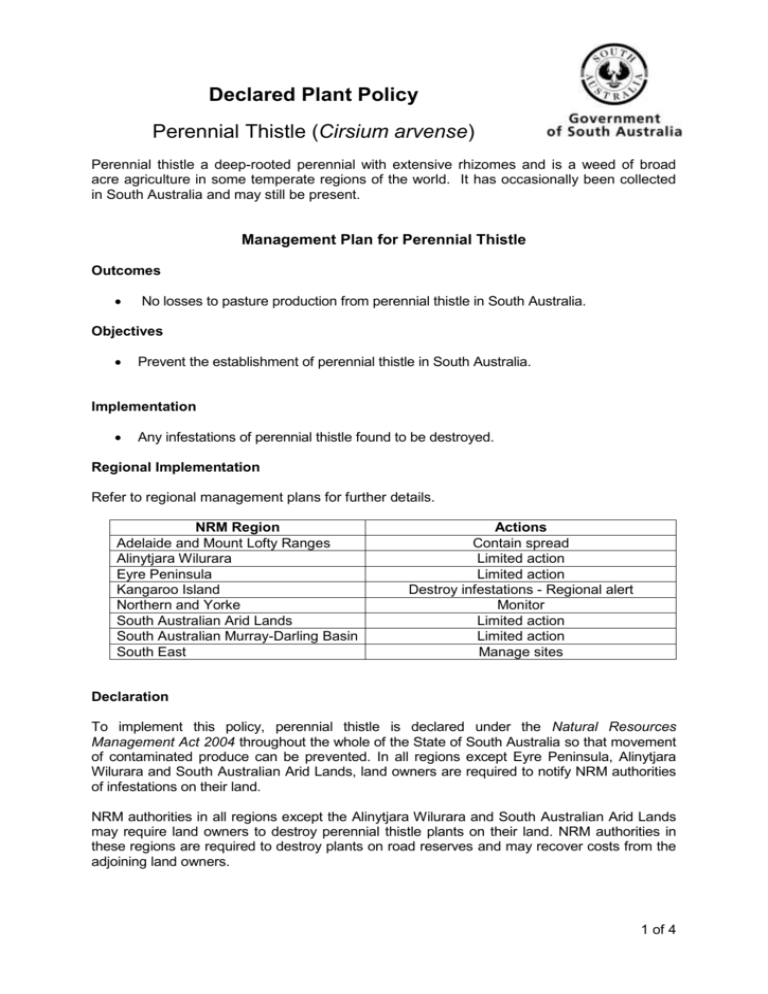
Declared Plant Policy Perennial Thistle (Cirsium arvense) Perennial thistle a deep-rooted perennial with extensive rhizomes and is a weed of broad acre agriculture in some temperate regions of the world. It has occasionally been collected in South Australia and may still be present. Management Plan for Perennial Thistle Outcomes No losses to pasture production from perennial thistle in South Australia. Objectives Prevent the establishment of perennial thistle in South Australia. Implementation Any infestations of perennial thistle found to be destroyed. Regional Implementation Refer to regional management plans for further details. NRM Region Adelaide and Mount Lofty Ranges Alinytjara Wilurara Eyre Peninsula Kangaroo Island Northern and Yorke South Australian Arid Lands South Australian Murray-Darling Basin South East Actions Contain spread Limited action Limited action Destroy infestations - Regional alert Monitor Limited action Limited action Manage sites Declaration To implement this policy, perennial thistle is declared under the Natural Resources Management Act 2004 throughout the whole of the State of South Australia so that movement of contaminated produce can be prevented. In all regions except Eyre Peninsula, Alinytjara Wilurara and South Australian Arid Lands, land owners are required to notify NRM authorities of infestations on their land. NRM authorities in all regions except the Alinytjara Wilurara and South Australian Arid Lands may require land owners to destroy perennial thistle plants on their land. NRM authorities in these regions are required to destroy plants on road reserves and may recover costs from the adjoining land owners. 1 of 4 Perennial Thistle policy Perennial thistle is declared in category 1 under the Act for the purpose of setting maximum penalties and for other purposes. Any permit to allow its movement or sale can only be issued by the Chief Officer pursuant to section 188. Under the Natural Resources Management (General) Regulations 2005, the transport or movement of grain for milling or wool for cleaning is exempt from the operation of sections 175 and the sale of wool or grain is exempt from section 177(2) if at the time of the sale the person believes on reasonable grounds that the purchaser will remove the plant from the wool or grain before any re-sale. The following sections of the Act apply to perennial thistle throughout each of the NRM regions noted below: X X X X X X X X X X X X X X X X X X X X SE X X X X SAAL NY X X X X SAMDB X KI X X X X X X EP 175(1) Prohibiting entry to area 175(2) Prohibiting movement on public roads 177(1) Prohibiting sale of the plant 177(2) Prohibiting sale of contaminated goods 180 Requiring notification of infestations 182(1) Landowners to destroy the plant on their properties 182(2) Landowners to control the plant on their properties 185 Recovery of control costs on adjoining road reserves AW Sections of Act AMLR Region X X X X X X X X X X X X X X Review This policy is to be reviewed by 2020, or in the event of a change in one or more regional management plans for perennial thistle. Weed Risk Invasiveness Unlike other thistles, perennial thistle is dioecious with separate male and female plants. It is insect pollinated so the male and female plants would need to be growing in the same locality for seed to be produced. Along with its perennial habit, this is characteristic of a plant forming permanent populations rather than an opportunist colonizer. However, seed can be produced in large quantities and is efficiently adapted for dispersal by wind. A new clonal infestation can reach several metres in diameter in the first two years of growth. Impacts Overseas and in Victoria, perennial thistle causes losses by competition with pasture and some cultivated crops in cool temperate climates. Potential distribution Although it was introduced in 1888, perennial thistle has never become established in South Australia. Isolated patches were previously found in the Mount Gambier area and Fleurieu Peninsula, suggesting that it can grow in the highest rainfall areas of the State or under irrigation. 2 of 4 Perennial Thistle policy Feasibility of Containment Control costs Control of established infestations requires a sustained management effort over several years. The timing of annual treatments is important; herbicide is translocated to the root system if applied to the rosettes, but much less if applied to plants in the bud stage. Persistence As a perennial, perennial thistle can regrow after grazing or slashing. It has no dormant or drought-resistant vegetative parts so is not likely to survive dry periods. Seed may be able to persist through these conditions but seed production would depend on both male and female plants being present. Current distribution No locations are currently known in South Australia. The State Herbarium has twentieth century specimens from Victor Harbor, Murtonga and Mount Gambier. Other incursions were destroyed at Piccadilly Valley and Hatherleigh. State Level Risk Assessment Assessment using the Biosecurity SA Weed Risk Management System gave the following comparative weed risk and feasibility of containment scores by land use: Land use Grazing - southern Irrigated pastures Weed Risk low 38 high 112 Feasibility of control very high 0 very high 0 Response at State Level monitor destroy infestations Considerations Perennial thistle was originally proclaimed because it is a significant weed in other countries and information on its potential in South Australia was lacking. Risk assessment indicates a management action of containment only to protect irrigated pastures and high-rainfall grazing. Only small areas of South Australia are potential habitat for perennial thistle. While sale and movement are prohibited uniformly across the State, regional actions vary according to the extent of the vulnerable land use in each region. Kangaroo Island treats perennial thistle as a regional alert since the island has high rainfall pastures and is free of the weed. The Adelaide and Mount Lofty Ranges region aims to contain spread by treating any new incursions, and the South East aims to manage sites. 3 of 4 Perennial Thistle policy Synonymy Cirsium arvense (L.) Scop., Fl. Carniolica edn 2, 2:126 (1772) Basionym Serratula arvensis L., Sp. Pl. edn 2, 2:1149 (1763) Nomenclatural synonym: Carduus arvensis (L.) Robson, Brit. Fl. 163 (1777). Taxonomic synonyms: Cirsium dioicum Cass., Dict. Sci. Nat., ed. 2. 27: 190 (1823). Cirsium incanum (S.G.Gmel.) M.Bieb., Fl. Taur.-Caucas. 3: 561 (1819). Other common names include Californian thistle, Canada thistle, corn thistle and creeping thistle. Hon Ian Hunter MLC Minister for Sustainability, Environment and Conservation Date: 3 January 2015 4 of 4
